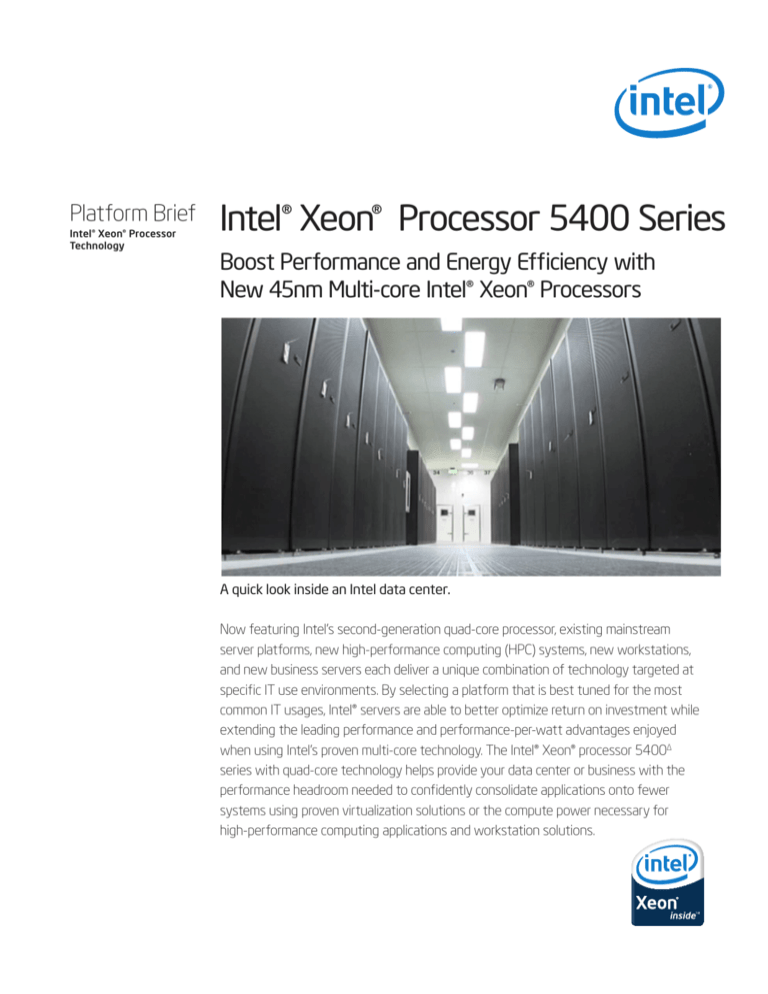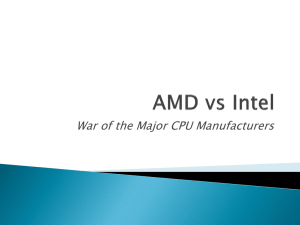
Platform Brief
Intel® Xeon® Processor
Technology
Intel® Xeon® Processor 5400 Series
Boost Performance and Energy Efficiency with
New 45nm Multi-core Intel® Xeon® Processors
Video will go here in PDF
A quick look inside an Intel data center.
Now featuring Intel’s second-generation quad-core processor, existing mainstream
server platforms, new high-performance computing (HPC) systems, new workstations,
and new business servers each deliver a unique combination of technology targeted at
specific IT use environments. By selecting a platform that is best tuned for the most
common IT usages, Intel® servers are able to better optimize return on investment while
extending the leading performance and performance-per-watt advantages enjoyed
when using Intel’s proven multi-core technology. The Intel® Xeon® processor 5400∆
series with quad-core technology helps provide your data center or business with the
performance headroom needed to confidently consolidate applications onto fewer
systems using proven virtualization solutions or the compute power necessary for
high-performance computing applications and workstation solutions.
More Innovation – Improved Value
Platforms that Optimize Return on
Investment and Increase Performance
Intel delivers much more than just fast servers. With platform
enhancements such as 45nm technology, Intel® Virtualization
Technology1 (Intel® VT), and an L2 cache that’s 50% larger, a
technology infrastructure built with Intel® Xeon® processor-based
platforms improves your return on IT assets while also helping to
make your company more efficient, responsive, and competitive.
The Intel® 45nm technology uses high-k dielectric materials
that are expected to fuel the ongoing performance advantages
predicted by Moore’s Law for years to come, and significantly
increases the transistor density over the previous Intel® 65nm
technology. Intel's 45nm packs 820 million transistors into the
Intel Xeon processor 5400 series versus the previous-generation
Intel® Xeon® processor 5300∆ series, which had an astounding
582 million transistors. More transistors means more capability,
performance and energy efficiency. Enhancements that include
expanded power management capabilities, enhancements
Innovation that Breaks
the Performance Barrier
designed to reduce virtualization overhead, and 47 new Intel®
New Intel Xeon processor 5400 series-based servers, HPC
systems, and workstations are built with 45nm enhanced
SSE4 instructions which can help improve the performance of
media and high-performance computing applications.
Intel® Core™ microarchitecture, previously code-named ”Penryn.”
Video will go here in PDF
Built for Virtualization
Intel Xeon processor 5400 series-based server platforms deliver
incremental headroom and performance for your two-processor
general-purpose server, so you can confidently consolidate
• Intel® VT FlexPriority, a new Intel® VT extension that
optimizes virtualization software efficiency by improving
interrupt handling.2
• Virtual Machine Device Queues (VMDq), which sort data
applications onto fewer systems with fewer cooling challenges,
through multiple queues in the silicon, resulting in efficient
giving you more performance and services per square foot.
network processing.
Platforms have integrated virtualization hardware support with
In addition, server platforms based on the Intel Xeon processor
Intel Virtualization Technology, which enables more efficient vir-
5400 series also support many Intel® advanced server technolo-
tualization solutions. Intel VT works by hardware-assisting your
gies that help companies enhance operations, reduce costs, and
virtualization environment and, in combination with powerful,
improve business continuity including:
reliable Intel Xeon processor 5400 series-based servers, boosts
asset utilization and IT flexibility while reducing costs and data
center power consumption. And new enhancements to Intel
VT coupled with 45nm technology speed up virtual machine
transition (entry/exit) times between 25 and 75 percent.
With the new Intel Xeon processor 5400 and 5200∆ series
offering maximum flexibility, IT managers can now build one
• 12 MB of L2 cache (50% larger) for greater performance
across most workloads.
• Fully Buffered DIMM (FBDIMM) technology which increases
memory speed to 800 MHz and significantly improves
data throughput.
• Memory mirroring and sparing which can predict a failing DIMM
compatible group of platforms for live migration across all of
and copy the data to a spare memory DIMM, maintaining server
their Intel Core microarchitecture-based servers including 2P
availability and uptime.
Intel® Xeon® processor 5100∆ series-based servers, 2P Intel
Xeon processor 5300 series, and the scalable 4P Intel® Xeon®
Delivering Compelling Performance Per Watt
processor 7300∆ series.
Intel has used its new 45nm process technology to extend its
The ability to conduct live VM migration offers tremendous
flexibility for fail-over, load-balancing, disaster-recovery, and
real-time server maintenance scenarios. And thanks to a new
feature called Intel® VT FlexMigration, IT will have the capability
to add new Intel Xeon processor 5400 series and future Intel
Xeon processor-based systems to the same resource pool when
using future versions of virtualization software. This gives IT
the power to choose the right server platform to best optimize
performance, cost, power and reliability. These processor
enhancements are further supplemented by:
Intel Core microarchitecture and deliver even higher levels of
performance and density with fewer cooling challenges. The
new 45nm Enhanced Intel Core microarchitecture delivers more
performance in the same platforms at the same power consumption, giving IT the flexibility to match performance, power and
cost requirements with your unique requirements and delivering
business and IT advantages beyond just pure performance.
Standard High-Volume
Server
The IT platform of choice since early 2006, the newest quad-core
Quad-Core or Dual-Core
processors, built with Intel’s high-performance, energy-efficient
New 45nm
Existing 65nm
• 5400 Series
• 5200 Series
• 5300 Series
• 5100 Series
• 5000 Series
performance than today’s leading quad-core Intel processors3 in
the same stable technology platform you rely on for the broadest
range of business needs across the data center, including e-mail,
Up to 2x 1333 MHz
Intel®
ESB2
I/O
Bridge
45nm manufacturing technology, deliver up to 25% more
departmental applications, Java application servers, financial
16 slots
Intel® 5000 Chipset
Configurable PCI Express* with 28 lanes
Intel® I/OAT
128 GB max
Fully Buffered
DDR2
applications and more.
The Energy Efficiency You Demand with
Even More Performance and Headroom
for Standard, High-Volume Servers
Servers based on the Intel Xeon processor 5400 series and the
Enhanced Intel Core microarchitecture help companies maximize
data center performance and density, and improve energy performance. Platforms based on Intel’s second-generation quad-core
Key Technologies
• 5 choices of multi-core CPUs on 1 platform
• 2 Intel Xeon processors
• Power-efficient Intel® Core™ microarchitecture
• Dedicated high-speed buses per CPU
• 16 slots and up to 64 GB memory
• 28 lanes PCIe standard
• Accelerated I/O solutions
technology make it easier to deliver more business services in
existing facilities, or condense applications for more efficient
operations at lower total cost of ownership (TCO).
Two-processor platforms based on the Intel Xeon processor
5400 series deliver 64-bit processing capabilities with 50%
more cache (12 MB of L2 cache per processor), providing more
computing for general purpose applications. The Intel Xeon processor 5400 series is ideal for dense computing environments
where excellent performance and performance per watt are key
requirements. The energy efficiency gained from the Intel Core
microarchitecture helps enable highly dense 80-watt or 50-watt
Key Capabilities
processor-based rack and blade form factors. This allows you to
• Exceptional performance and value for
take back control of data center cooling, power limitations, and
General-Purpose Servers including:
-e-mail
-Web
space constraints caused by server sprawl.
A dual-core option with a 6 MB L2 Cache is also available.
-File
Intel Xeon processors 5400 series and Intel® Xeon® processor
-Business apps
5200 series utilize a common microarchitecture, common socket
• IT infrastructure virtualization
and common platform as existing dual-core processors and
quad-core processors. This simply means that adding these
new powerful, energy-efficient servers to your data center is
easy and requires no software tuning and minimal hardware
qualification efforts.
4
High-Performance
Computing
Built with Intel's 45nm technology and optimized for high band-
Quad-Core or Dual-Core
width clusters and super computers, new HPC servers using
two Intel Xeon processor 5400 series processors have up to
8 computational engines delivering in excess of 100GFLOPS
to 64-bit applications and can deliver up to 30% for most HPC
4
applications and up to 50%5 for optimized workloads on high
compute applications over previous-generation processors.
Technical Compute Performance:
Impact Far Beyond the Data Center
New 45nm
• 5400 Series
• 5200 Series
Up to 2x 1600 MHz
Intel®
ESB2
I/O
Bridge
16 slots
Intel® 5400 Chipset
128 GB max
Fully Buffered
DDR2
At Intel, we recognize that you need more than just processors
that deliver greater performance in the data center. That’s why
we provide platform-based solutions that maximize performance,
improve throughput, and add new embedded technologies that
Configurable PCI Express* with 40 lanes
Dual x16 PCIe Gen 2
give business, creative, and scientific professionals the tools
to solve problems faster, process larger data sets, and meet
bigger challenges.
Two-processor technical compute server platforms based on
the Intel Xeon processor 5400 and 5200 series integrate greater
processing capabilities, faster I/O, and increased memory capacity.
Key Technologies
• 45nm Intel Xeon processors
• 50% larger L2 cache
These multi-core servers help maximize productivity, enhance
• 20% faster FSB (1600 MHz)
visualization, and improve flexibility to help researchers, engi-
• 2x bandwidth with PCIe gen 2
neers, and developers achieve more in less time.
Technical compute platforms based on the Intel Xeon processor
• Larger memory support (up to 128 GB)
• 40 lanes of configurable PCIe (gen 1 and 2)
5400 series deliver 8-thread, 32- and 64-bit processing capabilities with 12 MB of L2 cache per processor, providing more performance for threaded applications in a variety of deployments.
The Intel Xeon processor 5400 series delivers up to 30%4 higher
performance for most HPC applications and up to 50%5 higher
performance for optimized workloads over previous-generation
Key Capabilities
• Bandwidth-intensive applications
• High-Performance Clusters
• Multi-tasking user environments
Intel quad-core processors.
5
Business Server
Optimized for small and medium business, Intel Xeon processors
Quad-Core or Dual-Core
offer solid performance and performance per watt for basic
New 45nm
Existing 65nm
• 5200 Series
• 5400 Series
• 5300 Series
• 5100 Series
business needs without sacrificing affordability. The platform is
optimized for reduced cost and power consumption, featuring the
Intel® 5100 chipset and native DDR2 memory. This enables you to
run more applications with a smaller footprint and budget, giving
Up to 2x 1333 MHz
Intel®
ICH-9R
I/O
Bridge
you revolutionary ways to achieve more with less.
6 slots
Intel® 5100 Chipset
24 GBa
Native DDR2
Also configurable with
up to 32 GB Max memory
a
Configurable PCI Express* with 30 lanes
Power and Performance
for More Efficient Business
With today’s competitive and budget pressures, it is critical
that you get the maximum value and return from your resources.
Server solutions based on Intel Xeon processors deliver powerful
business capabilities at affordable prices, giving you the flexibility
you need to reach new customers, increase your revenue and
achieve your business goals. New 2-socket Intel Xeon processor
Key Technologies
5400 series-based servers deliver new levels of performance
• High-performance multi-core CPUs
for business processes, across a wide range of business work-
• Excellent investment protection
loads, including application servers, e-mail servers, Web servers
and more.
• Intel Xeon processor capable
• Power-efficient Intel Core microarchitecture
Intel’s second-generation quad-core processor , featuring a new
cost optimized Intel® 5100 Memory Controller Hub Chipset, and
• 6 slots of lower power DDR2 memory
low cost Intel ICH-9R I/O controller, and coupled with the energy
• Cost-optimized chipset and I/O controller
efficient technology found in Intel’s 45nm silicon process, enables
• 30 lanes of configurable PCIe
Key Capabilities
• Optimized for small- and medium-sized businesses
seeking enterprise-class performance and quality
on a constrained budget
• General-Purpose Servers including:
-e-mail
-Web
-File
-Business apps
6
improved IT application performance with excellent power efficiency and value. Supporting either one or two processors the
platform is further optimized for reduced power consumption
using low power native DDR2 memory. The high performance,
low power, and affordable technology found in these new business servers helps you to run more business applications within a
smaller IT footprint and giving you revolutionary ways to achieve
more with less.
Workstations
Quad-Core or Dual-Core
Intel also offers Intel Xeon processor-based workstations that
deliver the performance and flexibility to help users solve bigger
problems and create more effectively. These next-generation
workstations integrate capabilities for flexibility and productivity, helping you get more done in less time, while improving
user experience.
New 45nm
• 5400 Series
• 5200 Series
Up to 2x 1600 MHz
Optimized for multi-tasking environments enabling users to
quickly and efficiently transform complex data into actionable
information, the Intel Xeon processor 5400 series features a
Intel®
ESB2
I/O
Bridge
16 slots
Intel® 5400 Chipset
1600 MHz Front-Side Bus (FSB), x16 PCIe 2 and up to 3.2 GHz CPUs.
Built-In Efficiency for Parallel Workflows
Balanced systems based on Intel Xeon processor 5400 and
128 GB max
Fully Buffered
DDR2
Configurable PCI Express* with 40 lanes
Dual x16 PCIe Gen 2
5200 series are ideal for today’s demanding applications. With
more cores, a larger L2 cache, and enhanced dynamic execution
engines, you can render faster, analyze and display more data
with higher fidelity, and speed visual comparisons, getting up
Key Technologies
to 5x the throughput of previous-generation processors.
• 45nm Intel Xeon processors
6
Platform memory, improved store and forward algorithms, and
- Up to 3.2 GHz quad-core, 3.4 GHz dual-core
advanced I/O also help 32- and 64-bit applications process more
• 20% faster FSB (1600 MHz)
data faster and run more complex modeling and analyses, giving
• Dual x16 PCIe gen 2 graphic support
users the tools to be more productive and creative.
Technical compute servers and workstations based on Intel®
Xeon processor 5400 and 5200 series are supported by the new
Intel 5400 Chipset with high performing FSB that deliver up to
1600 MHz. In addition, a 24 MB snoop filter significantly reduces
data traffic on the FSB, providing lower latencies and greater
available bandwidth. The snoop filter maintains an index of the
current cached data in each processor, eliminating unnecessary
snoops and boosting available bandwidth.
• FBDIMM 800 MHz increase memory throughput
• 24 MB snoop filter boosts available bandwidth to CPU
• Larger memory support (up to 128 GB)
Key Capabilities
• Work with larger, more detailed complex designs
• Run multiple applications at once with good
system interactivity
• Speed up individual applications, specifically those that
take advantage of SMP (Symmetric Multi-Processing)
and threads
• Multi-tasking user environments
• Content creation
• Graphic-intensive applications
7
A Deep Look Inside the Enhanced
Intel® Core™ Microarchitecture
Building on the already rich Intel® 64 instruction set architecture
In addition, technical compute server platforms based on the
(ISA), Intel Xeon processor 5400 and 5200 series have new
Intel Xeon processor 5400 series also support many advanced
a instruction set that help the processors to deliver superior
technologies that help companies enhance operations, reduce
performance and energy efficiency to a broad range of 32-bit
costs, and speed productivity, including:
and 64-bit applications. These new instructions include:
• High-performance radix 16 dividers: that roughly double
• Streaming SIMD Extensions 4 (SSE4) that will provide building
the divider speed over previous generations for scientific
blocks for delivering expanded capabilities, enhanced perfor-
computations, 3D transformations, and other mathematically
mance, and greater energy efficiency for many applications.
intensive functions.
• Application Targeted Accelerators that will provide a
• Higher Bus Speeds: up to 1600 MHz for targeted segments
new foundation for delivering low latency, lower power
such as HPC.
fixed-function capabilities for targeted applications.
• Super Shuffle Engine: a single-pass shuffle unit that is
These instructions represent another milestone in Intel's new
128-bits wide, 45nm processors can perform this full-width
cadence for the continuous development of next-generation
shuffle in a single cycle. This significantly improves perfor-
silicon processes and processor architecture. Applications that
mance for SSE2, SSE3 and SSE4 instructions that have
will benefit include those involving graphics, video encoding and
shuffle-like operations such as pack, unpack and wider
processing, 3-D imaging, gaming, web servers, and application
packed shifts, increasing performance for content creation,
servers. High-performance applications that will benefit include
imaging, video, and high-performance computing.
data mining; database; complex searching and pattern matching
algorithms; audio, video, image, and data compression algorithms;
parsing and state machine-based algorithms; and many more.
• Intel’s dynamic acceleration: which uses the power
headroom freed up when a core is made inactive to boost
the performance of another still active core.
For more information, visit
www.intel.com/xeon.
Intel Xeon Processor 5400 Series Overview
Two-processor technical compute servers, standard high-volume servers, entry-level business servers,
and workstations based on the Intel Xeon processor 5400 series maximize performance and efficiency
with reliability and versatility.
Features
Benefits
Multi-Core Processing
• 45nm technology boosts performance on a range of workloads.
• Increased headroom for multi-threaded applications and heavy
multi-tasking scenarios.
• Helps boost system utilization through virtualization1 and application
responsiveness.
• Quad-core performance and cost/virtual machines.
• Platform-compatible with other and Intel® Xeon® processors for ease
of migration and IT stability.
Enhanced Intel® Core™
Microarchitecture
• Boosts performance on multiple applications/user environments
and data-demanding workloads, while enabling denser data center
deployments through improved performance per watt.
• The new 45nm Enhanced Intel Core microarchitecture delivers
up to 35% more performance in the same platforms and at the
same power consumption.7
• Reduced idle processor power, lowers average server power consumption.
Large 12 MB of on-die L2 Cache
(2 x 6 MB)
• Increases efficiency of L2 Cache-to-core data transfers, maximizing
main memory to processor bandwidth.
• Reduces latency by storing larger data sets closer to the processor,
reducing the number of trips to main memory.
• Up to 6 MB of L2 Cache can be allocated to one core.
Intel® Virtualization Technology1
• A suite of processor enhancements that assists virtualization software
to deliver more efficient virtualization solutions and greater capabilities
including 64-bit guest OS support.
• Intel® VT FlexPriority, a new Intel® VT extension that optimizes virtualization
software efficiency by improving interrupt handling.2
• Intel® VT FlexMigration enables Intel Xeon processor 5400 and 5200
series-based systems to be added to the existing virtualization pool with
single, 2, or 4+ socket Intel Core microarchitecture-based servers.
Enhanced Front-Side Bus
• New dedicated high-speed bus design enables increased throughput
and bandwidth between each of the processors and the chipset.
• Supporting up to 1600 MHz depending on chipset.
Intel® 64 Architecture8
• Flexibility for 64-bit and 32-bit applications and operating systems.
Eco-Friendly Manufacturing
• Lead-free processors in 45nm high-k metal gate process technology.
• Halogen-free packaging for all Intel Xeon processors 5400 and 5200 series.
9
What is the 5000 Sequence?
At Intel, our processor series numbers are intended to help clarify processor features, capabilities
and intended usages. Intel offers four processor number sequences for server applications:
Intel® Xeon® processor 3000 sequence
Intel® Xeon® processor 7000 sequence
One-processor servers for small business,
Greater scalability with 4- to 32-processor
entry, or first server based on the Intel
enterprise servers based on the Intel Xeon
Xeon processor.
processor.
Intel® Xeon® processor 5000 sequence
Intel® Itanium® processor 9000 sequence
Two-processor general-purpose, standard
Maximum performance and scalability for
high-volume servers, HPC systems, and work-
RISC replacement usage with 2- to 512-
stations based on the Intel Xeon processor.
processor servers.
Intel® Xeon® Processor 5400 Series
The Intel Xeon processor 5400 series is available in a range of features to match different computing
demands. All processors integrate Intel Virtualization Technology and Intel® 64 Architecture,8 and
are available in the LGA771 packaging. Dual-core SKU options are also available. Intel Virtualization
Technology, Intel FlexMigration, Intel FlexPriority and Intel 64 Architecture are standard on all SKUs.
With the exception of E5405, all SKUs also support Demand Based Switching.
Processor Number∆
CPU
Frequency
L2 Cache
Front-Side
Bus Speed
Power
Number
of Cores
Intel® Xeon® Processor X5492a
3.40 GHz
12 MB
1600 MHz
150W
4
Intel® Xeon® Processor X5470
3.33 GHz
12 MB
1333 MHz
120W
4
Intel® Xeon® Processor X5482
3.20 GHz
12 MB
1600 MHz
120W
4
Intel® Xeon® Processor X5472
3.00 GHz
12 MB
1600 MHz
120W
4
Intel® Xeon® Processor E5472
3.00 GHz
12 MB
1600MHz
80W
4
Intel® Xeon® Processor E5462
2.80 GHz
12 MB
1600 MHz
80W
4
Intel® Xeon® Processor X5460
3.16 GHz
12 MB
1333 MHz
120W
4
Intel® Xeon® Processor X5450
3.00 GHz
12 MB
1333 MHz
120W
4
Intel® Xeon® Processor E5450
3.00 GHz
12 MB
1333 MHz
80W
4
Intel® Xeon® Processor E5440
2.83 GHz
12 MB
1333 MHz
80W
4
Intel® Xeon® Processor L5430
2.66 GHz
12 MB
1333 MHz
50W
4
Intel® Xeon® Processor E5430
2.66 GHz
12 MB
1333 MHz
80W
4
Intel® Xeon® Processor L5420
2.50 GHz
12 MB
1333 MHz
50W
4
Intel® Xeon® Processor E5420
2.50 GHz
12 MB
1333 MHz
80W
4
Intel® Xeon® Processor L5410
2.33 GHz
12 MB
1333 MHz
50W
4
Intel® Xeon® Processor E5410
2.33 GHz
12 MB
1333 MHz
80W
4
Intel® Xeon® Processor E5405
2.00 GHz
12 MB
1333 MHz
80W
4
Intel® Xeon® Processor X5272
3.40 GHz
6 MB
1600 MHz
80W
2
Intel® Xeon® Processor X5270b
3.50 GHz
6 MB
1333 MHz
80W
2
Intel® Xeon® Processor X5260
3.33 GHz
6 MB
1333 MHz
80W
2
Intel® Xeon® Processor L5240
3.00 GHz
6 MB
1333 MHz
40W
2
Intel® Xeon® Processor E5205
1.86 GHz
6 MB
1066 MHz
65W
2
Workstation only
b
The Intel® Xeon® X5270 will be available in October 2008.
a
10
Systems Designed
for Your Needs
High-Performance Computing Systems
and Workstation: Intel® 5400 Chipset
The Intel® 5400 chipset improves data movement across
Intel Xeon processor 5400 series-based workstations and
HPC systems by increasing interconnect bandwidth, optimizing
system bandwidth, increasing memory capacity, and improving
network traffic processing while reducing I/O latency. These
platform advancements help to match the improved performance of the Intel Xeon processor 5400 series and include
a 1600 MHz Front-Side Bus, a 24 MB Snoop Filter to reduce
traffic on the Front-Side Bus, and support for dual x16 PCIe
gen 2 ports to support I/O-intensive applications.
Entry-Level Business Servers:
Intel® 5100 Chipset
The new Intel® 5100 MCH Chipset supports both quad- and dualcore computing and is ideal for small and medium businesses. The
chipset offers energy-efficient performance and the reliability
you need. With Intel® Virtualization, DDR2, PCI Express,* serial ATA
RAID, Intel® Active Management Technology,9 and 1066/1333
MHz DIB to improve network traffic processing.
Standard, High-Volume Servers:
Intel® 5000p or 5000v Chipsets
Widely deployed since mid-2006 for enterprise and business
with existing Intel Xeon processors, two chipset versions enable
flexible server configuration to meet your goals.
Performance: Intel® 5000p chipset – This chipset supports
1066 and 1333 MHz system bus speeds, three PCI Express x8
links (each configurable as two x4 links), FBDIMM 533 and 667
technology, point-to-point connection for Intel® 6321 ESB I/O
Controller Hub at 2 GB/s, and Intel® 6700PXH 64-bit PCI hub.
Value: Intel® 5000v chipset – This chipset supports 1066 and
1333 MHz system bus speeds, one PCI Express x8 link (configurable as two x4 links), FBDIMM 533 and 667 technology, point-topoint connection for Intel® 6321 ESB I/O Controller Hub at 2 GB/s,
and Intel® 6700PXH 64-bit PCI hub.
11
Performance Results
Mainstream Enterprise Servers
SPECjbb2005*: X5460 vs X5365 - Published/measured results on SPECjbb2005* - Oct 2, 07
Comparison between 5160, X5365 and X5450 based on SPECjbb2005 benchmark result
Quad-Core Intel ® Xeon® processor X5365 based platform details: Dell PowerEdge* 1950 platform with two Quad-Core Intel Xeon processor X5365 3.0GHz, 2x4Mb L2 Cache, 1333 MHz
system bus, 16GB Memory DDR2-667 FBDIMM, Microsoft Windows Server 2003 Enterprise x64 Edition SP1 (64-bit), BEA JRockit 5.0 P27.2.0. Measured at 238,472 bops and 59,618
bops/JVM. For more information see http://www.spec.org/jbb2005/results/res2007q3/jbb2005-20070810-00346.html
Quad-Core Intel ® Xeon® processor X5460 based platform details: Intel Server pre-production platform with two Quad-Core Intel Xeon processor X5460 3.16GHz, 2x6Mb L2 Cache, 1333
MHz system bus, 16GB Memory DDR2-667 FBDIMM, Microsoft Windows Server 2003 Enterprise x64 Edition SP1 (64-bit), BEA JRockit 5.0 P27.2.0. Intel internal measurement – September
2007
SPECint*_ rate2006: X5460 vs X5365 - Published/measured results on SPECint*_ rate2006 - Oct 2, 07 with 64-Bit SUSE LINUX Enterprise Server 10 16GB (8x2GB). SPEC binaries built
with Intel Compiler 10.1 for 32-bit/64-bit Linux
Quad-Core Intel Xeon 5400 Series based platform (“Bensley/Harpertown”) common configuration details: Intel server pre-production platform with two Quad-Core Intel Xeon Processor
X5460 (3.16GHz) w/ 2x6M L2 Cache, 1333 MHz FSB, 5000p “Blackford” Chipset. All measurements use FB DDR2-667 MHz memory
Quad-Core Intel Xeon 5300 Series based platform (“Bensley/Clovertown”) common configuration details: Intel server pre-production platform with two Quad-Core Intel Xeon Processor
X5365 (3.00GHz) w/ 2x4M L2 Cache, 1333 MHz FSB, 5000p “Blackford” Chipset. All measurements use FB DDR2-667 MHz memory
Workstations: Workstation and Multi-Tasking Enhancements
SPECfp_rate2006
Quad-Core Intel Xeon processor X5365 based platform details: Supermicro* X7DB8 with two Quad-Core Intel Xeon processors X5365 3.0GHz, 16 GB memory (8x2GB), 1333 FSB, O/S
64-Bit SUSE Linux Enterprise Server 10, Kernel 2.6.16.21-0.8-smp for x86_64, Intel C++ Compiler for Linux version 10.1 & Smart Heap Library Version 8.1. Published at www.spec.org as
of September 4th 2007 at 66.9.
45nm Hi-k Intel Xeon Quad-Core processor 3.20Ghz based platform details: Intel pre-production platform with two 45nm Hi-k Intel Xeon Quad-Core processors 3.20GHz, 1600 FSB, 16 GB
memory (8x2GB), O/S 64-Bit SUSE Linux Enterprise Server 10, Kernel 2.6.16.21-0.8-smp for x86_64, Intel C++ Compiler for Linux version 10.1 & Smart Heap Library Version 8.1. Result
measured at 89.8.
Manufacturing “Working Differently” scenario SPECapc* SolidWorks* 2005 and Fluent* 6.3.26 L1/L2 workloads running 5x concurrently
2x Quad-Core Intel ® Xeon® Processor 5400-series (3.20 GHz, 1600 MHz FSB, 12 MB cache, formerly “Harpertown”) on “SunCity Stoakley” pre-production workstation compared to 2x
Quad-Core Intel Xeon Processor X5365 (3.00 GHz, 1333 MHz FSB, 8 MB cache) on SuperMicro* X7DA8 workstation, COMMON: 8 GB FBD-667 memory, WDC WD740GD HDD, Windows
XP* Professional x64 SP1, NVIDIA* Quadro* FX 4500 PCIe* x16 video card driver 91.36.
Technical Compute Servers
Weather Modeling (National Weather Services Application) and Financial Services (Black-Scholes application) running 8 threads with Red Hat EL4-U4 64-bit; 2.6.9-42.ELsmp
Quad-Core Intel Xeon 5300 Series based platform (“Bensley/Clovertown”) common configuration details: Intel server pre-production platform with two Quad-Core Intel Xeon Processor
X5365 (3.00GHz) w/ 2x4M L2 Cache, 1333 MHz FSB, 5000p “Blackford” Chipset. All measurements use 32GB (16x2GB) FB DDR2-667 MHz memory
Quad-Core Intel Xeon 5400 Series based platform (“Stoakley/Harpertown”) common configuration details: Intel server pre-production platform with two Quad-Core Intel Xeon Processor
X5472 (3.0GHz) w/ 2x6M L2 Cache, 1600 MHz FSB, 5xxx “Seaburg” Chipset. All measurements use 16GB (16x1GB) FB DDR2-800 MHz memory
Performance and competitive information is accurate at the time of document publication. For the latest performance and competitive information, visit www.intel.com/performance.
∆
Intel ® processor numbers are not a measure of performance. Processor numbers differentiate features within each processor series, not across different processor sequences.
See http://www.intel.com/products/processor_number for details.
Intel Virtualization Technology requires a computer system with a processor, chipset, BIOS, virtual machine monitor (VMM) and applications enabled for virtualization technology.
Functionality, performance or other virtualization technology benefits will vary depending on hardware and software configurations. Virtualization technology-enabled BIOS and VMM applications are currently in development.
1
Intel internal measurement. Platforms running 4 x Intel ® Xeon® Processor X7350, 32GB memory, vConsolidate Beta 2, Virtual Iron 4.0.2 software. 1 CSU configuration, Sept 2007. Boot time
improvement measured on Windows XP. vConsolidate measurement conducted by configuring the system with Windows 2000 SP4
2
Quad-Core Intel ® Xeon® Processor 5300 Series (“CTN”)Up to 25% (1.25x) higher Performance for Intel Xeon processor X5460 vs Intel Xeon processor X5365 - Published/measured results
on SPECjbb2005* - Oct 2, 07. Quad-Core Intel ® Xeon® processor X5365 based platform details: Dell PowerEdge* 1950 platform with two Quad-Core Intel Xeon processor X5365 3.0GHz,
2x4Mb L2 Cache, 1333 MHz system bus, 16GB Memory DDR2-667 FBDIMM, Microsoft Windows Server 2003 Enterprise x64 Edition SP1 (64-bit), BEA JRockit 5.0 P27.2.0. Measured at
238,472 bops and 59,618 bops/JVM. For more information see http://www.spec.org/jbb2005/results/res2007q3/jbb2005-20070810-00346.html Quad-Core Intel ® Xeon® processor X5460
based platform details: Intel Server pre-production platform with two Quad-Core Intel Xeon processor X5460 3.16GHz, 2x6Mb L2 Cache, 1333 MHz system bus, 16GB Memory DDR2-667
FBDIMM, Microsoft Windows Server 2003 Enterprise x64 Edition SP1 (64-bit), BEA JRockit 5.0 P27.2.0. Intel internal measurement – September 2007
3
Source: Intel measured results Oct 2, 2007 for SPECfp_rate_base2006* comparing Xeon X5472 (3.0GHz/12M L2 Cache/1600 MHz FSB, 5400 Chipset (pre-production platform) to Xeon
X5365 (3.00GHz/8M L2 Cache/1333 MHz FSB). 2 (up to 50%) Source: Intel measured results Oct 2, 2007 for Financial Services (Black-Scholes application) running 8 threads with Red Hat
EL4-U4 64-bit; 2.6.9-42.ELsmp comparing Quad-Core Intel Xeon 5300 Series based platform X5365 (3.00GHz/8M L2 Cache/1333 MHz FSB) to pre-production Quad-Core Intel Xeon 5400
Series based platform X5472 (3.0GHz/12M L2 Cache/1600 MHz FSB, 5400 Chipset (pre-production platform)
4
Based on measured result on SPECfp*_rate2006 benchmark. SPEC binaries built with Intel Compiler 10.1 for 64-bit Linux. Servers are configured with 64-Bit SUSE LINUX Enterprise Server
10 and 16GB (8x2GB) of memory.
5
Intel internal measurement as of May 10, 2007 using SPECint_rate_base2000* with Intel Xeon Tigerton Processor 2.93GHz. Results compare Intel measured Quad-Core Intel Xeon Tigerton
Processor (2.66GHz) or (2.93GHz), with 2x4M L2 Cache, 1066 MHz system bus, Clarksboro Chipset vs. published Dual-Core AMD Opteron* Model 8220SE (2.8SktF).
6
Intel Server pre-production platform with two Quad-Core Intel Xeon processor E5450 3.0GHz, 2x6Mb L2 Cache or E5335, 2x4MB L2 Cache, 1333 MHz system bus, 16GB Memory DDR2667 FBDIMM, Microsoft Windows Server 2003 Enterprise x64 Edition SP1 (64-bit), BEA JRockit 5.0 P27.2.0. Intel internal measurement – September 2007. Perf/Watt calculated by dividing
the Performance by measured system power during steady state window.
7
64-bit computing on Intel architecture requires a computer system with a processor, chipset, BIOS, operating system, device drivers and applications enabled for Intel ® 64 architecture.
Performance will vary depending on your hardware and software configurations. Consult with your system vendor for more information.
8
Intel ® Active Management Technology requires the platform to have an Intel ® AMT-enabled chipset, network hardware and software, as well as connection with a
power source and a corporate network connection. With regard to notebooks, Intel AMT may not be available or certain capabilities may be limited over a host
OS-based VPN or when connecting wirelessly, on battery power, sleeping, hibernating or powered off. For more information,
see www.intel.com/technology/platform-technology/intel-amt/
9
Copyright © 2008 Intel Corporation. All rights reserved. Intel, the Intel logo, Xeon, Intel Core, and Itanium are trademarks of Intel Corporation in the U.S.
and other countries.
*Other names and brands may be claimed as the property of others.
Printed in USA
0908/HW/OCG/XX/PDF
Please Recycle
319108-002US








